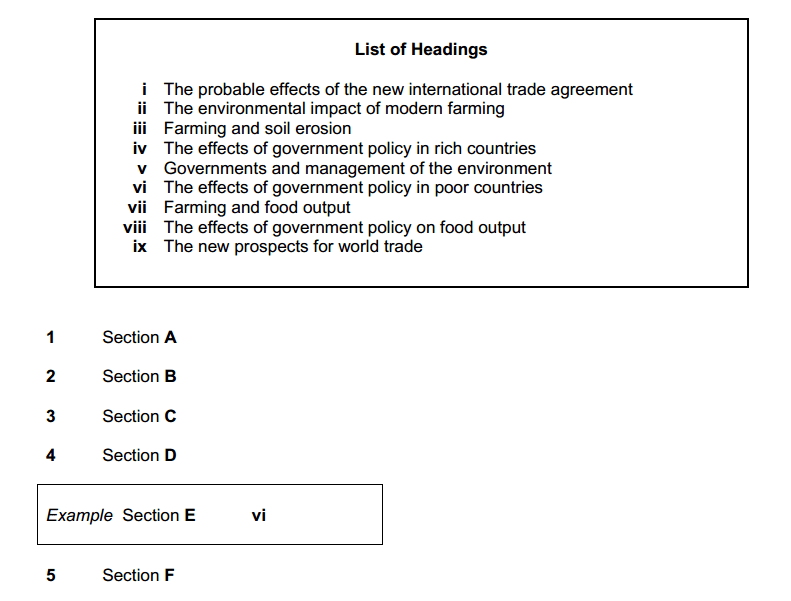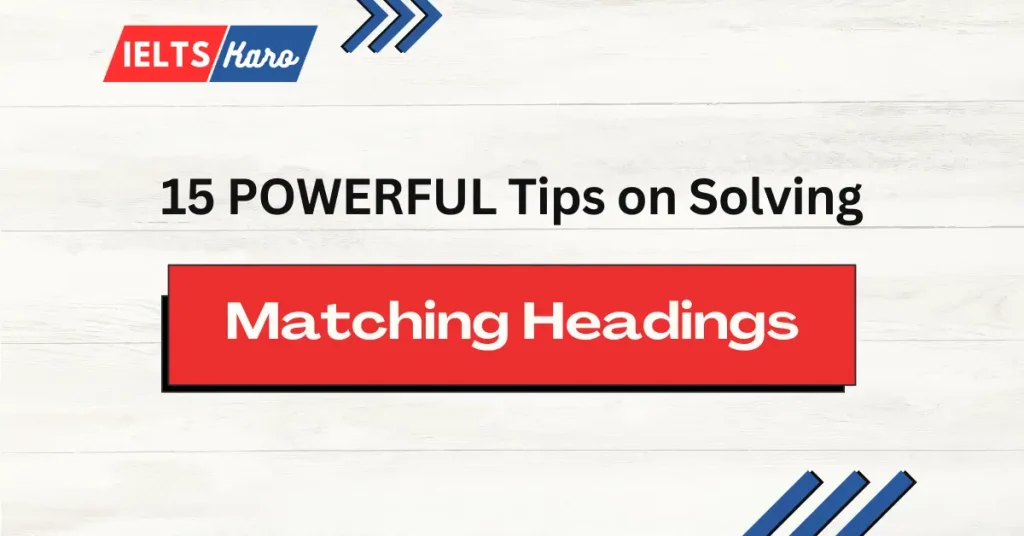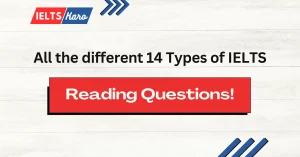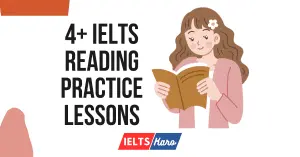Understanding the IELTS Reading Matching Headings Task
You’re not alone in the quest for an IELTS Reading score that wows. I know firsthand how challenging the IELTS Reading Matching Headings section can be. But trust me, with the right approach, even this daunting task can become manageable. As someone who secured an 8.5 in IELTS Reading, I’ve been where you are, grappling with complex texts and a sea of headings. Let’s dive in together and demystify this section.
IELTS Reading Matching Headings is one of the 14 types of questions and extremely crucial because it tests your understanding of the overall structure and main ideas of the text. Most of my students find these questions extremely difficult and challenging. This is because some of the headings may actually look similar, but in reality there is ONLY one correct heading for each passage.
In this blog, I will share 13 proven tips based on my experience of scoring an 8.5 in IELTS Reading, on Matching Headings. You can count on me;)
The Structure of the Matching Headings Task
What the Task Involves
In the Matching Headings task, you are given a list of headings and a passage divided into paragraphs or sections. Your job is to match each heading to the correct paragraph. The headings summarise the main idea or theme of the paragraph, so your goal is to identify which heading best describes the content of each paragraph.
Types of Passages You May Encounter
The passages in the IELTS Reading section can vary widely, from academic topics to general interest subjects. You may encounter descriptive texts, argumentative essays, or even historical accounts. Understanding the type of text you’re dealing with can help you better anticipate the structure and main ideas.
Typical Challenges Faced by Test-Takers
One of the biggest challenges in the Matching Headings task is dealing with similar or overlapping ideas. Sometimes, two headings may seem to fit the same paragraph, or a heading might appear to be relevant to multiple sections. Additionally, the use of synonyms and paraphrasing can make it difficult to identify the correct match.
Be very clear that there is ONLY one correct heading, even if it may seem otherwise. This is usually a trap and the only way to ace it is by having a strong grip over synonyms.
Strategies for Successfully Matching Headings
It is obvious that understanding and solving such a challenging type of question requires a strategy, without which you will only consume up a lot of time with nothing left to practise. Here are some practical tips and tricks on how to successfully do the IELTS Reading Matching Headings part:
- There is only one correct heading for each paragraph, which never repeats itself. If you find a heading repeating, read both paragraphs and select an appropriate heading that closely resembles that passage.
- You need NOT write the heading. Rather, the numeral is written (on paper) or selected (on computer)
- Many of my students opt for reading the heading first and then searching for the appropriate passage. Others read a passage first and then scan for the right heading. I went with the latter (yup, I have had an 8.5). It all depends on what works best for you. As long as you are understanding the passage and matching the heading, all should be fine.
- Always count on the number of paragraphs and headings. Most of the times, you will have more headings than paragraphs, but it doesn’t work all the time.
- There may or may not be more headings than the paragraphs. Hence, you need to decide carefully if all headings will be used.
- If you opt for a computer-based test, you will see headings and the passages side-by-side on the computer screen. On a paper-based test, you get them on a different piece of paper. Nevertheless, this shouldn’t deter you from solving them.
- The heading encapsulates the main idea of the passage. Always double check that the heading you selected correctly summarises the key point(s) of the paragraph. This is NOT the same as Matching paragraph information, where you can have 2 statements from one paragraph.
- When you have a strong grip over synonyms, make sure to pay close attention to headings that often feel very same or similar. You do not want to mess this one up!
- Spend time paraphrasing keywords in the possible headings. You will use keywords and key paraphrases to decide which paragraphs or headings are possible. Then you analyse deeper meaning before deciding your answer.
- Always understand the main ideas of the paragraph and choose a heading that matches accordingly.
- There is a main idea and extra information:
- Main idea – Best for heading
- Extra information – does NOT sum up the main idea and cannot be used to describe the heading.
- Some headings may match information from the paragraph, but your goal is to find one heading that perfectly captures the entire idea of the passage, and not just some extra information.
- Headings are challenging, but that doesn’t mean that you spend far too much time on completing them. Remember that there are 40 questions in total and you only have 60 minutes to solve. Hence, do not spend more than a minute if you ever get stuck.
- Underline the keywords as you read the passage.
- Always read and focus on the first two lines and the last line from the passage. Most of the times, these lines perfectly sum up the main idea.
Skimming vs. Scanning
To tackle the Matching Headings task, it’s essential to use effective reading techniques like skimming and scanning. Skimming involves quickly reading through the passage to get a general sense of the content, while scanning focuses on locating specific information. By skimming first, you can understand the overall structure, making it easier to match headings later.
How to Identify Main Ideas?
Each paragraph in the passage will have a main idea, often found in the topic sentence, which is usually at the beginning or end of the paragraph. Pay close attention to these sentences, as they often summarise the content and can guide you in selecting the correct heading.
Importance of Keywords in Headings and Text
Keywords are crucial in the Matching Headings task. Both the headings and the text will contain keywords that hint at the main idea. Look for these keywords and their synonyms to help you match the heading to the correct paragraph. However, be careful of keywords that appear in multiple headings, as this can be a trap.
Understanding Paraphrasing and Synonyms
The IELTS exam is known for using paraphrasing and synonyms, especially in the Matching Headings task. This means that the wording in the headings may not exactly match the text. To succeed, you need to recognize when a different word or phrase has the same meaning as the one in the passage.
Common Pitfalls and How to Avoid Them
Misleading Words and Phrases
One common pitfall is getting distracted by misleading words or phrases that seem to match the heading but don’t capture the paragraph’s main idea. It’s important to focus on the overall meaning rather than just matching words.
Overthinking the Headings
Another mistake is overthinking the headings. Sometimes, students will spend too much time trying to find the “perfect” match, which can lead to confusion and wasted time. Trust your initial judgement and move on if you’re unsure; you can always come back to it later.
Timing Issues
Managing your time during the IELTS Reading section is crucial. The Matching Headings task can be time-consuming, so it’s important not to get stuck on any one heading. Aim to complete this task within 10-15 minutes, leaving enough time for other questions.
Practical Tips for the Matching Headings Task
Practice Regularly with Sample Tests
The best way to improve your skills in the Matching Headings task is through regular practice from the IELTS Cambridge test books. Use sample tests and past papers to familiarise yourself with the format and types of passages you’ll encounter. This will also help you build speed and accuracy.
Learn to Manage Your Time Effectively
Time management is key to success in the IELTS Reading section. Develop a strategy for allocating time to each task, and stick to it. If you find a particular heading difficult, move on and return to it later if time permits.
Familiarise Yourself with Different Text Types
Since the IELTS Reading section includes a variety of text types, it’s beneficial to familiarise yourself with as many as possible. This will help you quickly identify the structure and main ideas, making the Matching Headings task easier.
IELTS Reading Matching Headings Example Practice Lessons
Reading Passage 1: Global Demand for Energy
Headings:
- The rise of renewable energy
- The impact of industrialization on the environment
- Challenges in global healthcare
Sample Paragraph: “The increasing demand for energy has led to significant advancements in renewable energy technologies. Solar, wind, and hydroelectric power are now more efficient and accessible than ever before, providing a cleaner alternative to fossil fuels.”
Answer:
For the sample paragraph provided, the correct heading would be “The rise of renewable energy.” The paragraph’s main idea revolves around the advancements and benefits of renewable energy, which matches the heading.
Reading Passage 2: Global Demand for Energy
Choose the correct heading for sections A-D and F from the list of headings below.
Write the correct number i-ix in boxes 1-5 on your answer sheet.

Section A
Government involvement in environmental management is complex and unavoidable. While sometimes inept at managing their own resources, governments often exacerbate problems by subsidising the exploitation and consumption of natural resources. Policies such as farm subsidies and coal mining protections harm the environment and are economically unsound. Eliminating these policies would benefit both the environment and the economy. Growth and environmental protection can coexist if political leaders can overcome vested interests.
Section B
Farming is the most significant human activity impacting the Earth’s surface, occupying a third of the planet’s land and expanding. Global food production per person increased 4% between the 1970s and 1980s, primarily due to higher yields on existing farmland and expanded cultivation. These increased yields resulted from irrigation, improved crop varieties, and a dramatic rise in pesticide and fertiliser use.
Section C
These agricultural practices have detrimental environmental consequences. Deforestation for agriculture is rampant, while chemical runoff contaminates water sources. Intensive farming and reduced fallow periods worsen soil erosion. The shift to monoculture and high-yield crops has eliminated diverse crop varieties essential for pest and disease resistance. Soil erosion threatens agricultural productivity worldwide. The United States has experienced significant topsoil loss, prompting land conversion programs. India and China face even more severe erosion.
Section D
Government policies intensify agriculture’s environmental impact. Subsidies in developed countries inflate land prices and encourage excessive fertiliser and pesticide use. These subsidies are substantial, exceeding total World Bank lending in the 1980s. Some countries have reduced subsidies, with New Zealand leading by eliminating most support. This resulted in decreased fertiliser use, reduced land clearing, and farm diversification. However, subsidies for soil erosion management were detrimental. Other countries have reduced but not eliminated subsidies, introducing payments for environmentally friendly practices. While these payments are necessary, they are unpopular with farmers. Some countries explore biofuel production from crops but these often require subsidies and have environmental drawbacks.
Section E
Developing countries face additional environmental challenges due to government policies. Subsidies for pesticides and fertilisers encourage overuse, leading to health risks and environmental degradation. Pesticide poisoning is a significant issue in developing countries, and excessive fertiliser use contributes to soil erosion.
Section F
Reduced agricultural subsidies in developed countries due to trade agreements may shift food production to regions with lower subsidies. While this could increase pressure on natural habitats, it may also benefit the environment. Reduced intensive farming and chemical use in developed countries are expected, while developing countries may improve land management practices with increased income. Effective and efficient use of soil and water is crucial to feeding a growing global population.
Click to reveal answers
Section A. V
Section B. VII
Section C. II
Section D. IV
Section F. I
Conclusion
Recap of Key Strategies
Mastering the Matching Headings task in the IELTS Reading section requires a combination of skimming, scanning, understanding keywords, and recognizing paraphrasing. By practicing these strategies regularly, you can improve your accuracy and speed, boosting your overall score.
Encouragement for Continuous Practice
Remember, practice makes perfect. The more you practice, the more familiar you’ll become with the types of passages and headings you’ll encounter. Stay consistent, and you’ll see significant improvement in your performance.
External resources to help you:
FAQs
What should I do if two headings seem to fit the same paragraph?
If two headings seem to fit the same paragraph, look closely at the details. Try to identify the main idea and how it relates to the overall passage. If you’re still unsure, make your best guess and move on; you can revisit it later if you have time.
How can I improve my speed in the Matching Headings task?
To improve your speed, practice skimming and scanning techniques. The more you practice, the quicker you’ll become at identifying main ideas and matching headings.
Are there any specific books or resources for practice?
Yes, there are several resources available, including IELTS practice books like “The Official Cambridge Guide to IELTS” and online platforms like IELTS Liz and British Council’s IELTS practice tests.
How much time should I spend on this task during the exam?
Aim to spend about 10-15 minutes on the Matching Headings task. This will give you enough time to complete other tasks in the Reading section.
Is it okay to skip difficult headings and come back to them later?
Yes, if you find a heading difficult, it’s better to skip it and return later. This strategy ensures that you don’t waste valuable time and can complete other tasks in the meantime.





